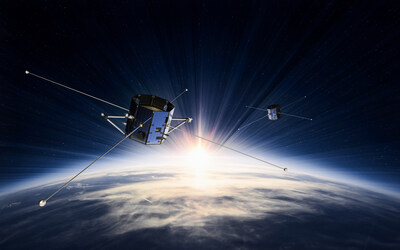Millennium Spacecraft for NASA TRACERS Mission Moves to Testing Phase
Rhea-AI Summary
Millennium Space Systems, a Boeing company, has completed two spacecraft for NASA's TRACERS mission, designed to study the interaction between solar wind and Earth's magnetic field. The project is now moving to the instrument integration and environmental testing phase before delivery to Vandenberg Space Force Base. Once launched into sun-synchronous orbit, the spacecraft will study magnetic reconnection and cusp electrodynamics in Earth's polar cusp region, collecting data to improve space weather forecasting capabilities. The mission features five different instruments from four institutions integrated into a spin-stabilized ALTAIR bus platform.
Positive
- Successful completion of two spacecraft for NASA mission
- Project advancing to testing phase, indicating progress in timeline
- Secured NASA contract for space weather research mission
Negative
- None.
News Market Reaction 1 Alert
On the day this news was published, BA declined 2.54%, reflecting a moderate negative market reaction.
Data tracked by StockTitan Argus on the day of publication.
"TRACERS will ultimately inform how we understand space weather," said Dave Machuga, CEO, Millennium Space Systems. "From a national security space perspective, this is incredibly important to understanding the environment our satellites – or any satellites – operate in."
The team is now integrating the instruments that will study changes in the magnetic and electric field, plasma particles and waves once in orbit. Following integration, the next phase is environmental testing prior to delivering the spacecraft to Vandenberg Space Force Base.
"TRACERS will determine fundamental properties of the process that connects the solar wind to near-Earth space and ultimately drives space weather," said David Miles, Principal Investigator of the TRACERS mission and F Wendell Miller Associate Professor at the University of
Once launched and in a sun-synchronous orbit, Millennium will begin on-orbit mission operations as the TRACERS spacecraft travels along Earth's polar cusp region, the funnel shaped regions of the Earth's magnetic field that open over the north and south magnetic poles.
"The TRACERS Instrument Suite incorporates five different instruments from four different institutions, each presenting unique accommodation," said Richard Prasad, TRACERS program manager, Millennium Space Systems. "Millennium adapted a standard
The data collected will focus on magnetic reconnection and cusp electrodynamics – two crucial mechanisms driving space weather. By examining the interactions between solar wind and the magnetosphere in the cusp region, TRACERS aims to enhance the understanding of how Earth's magnetosphere functions and how it reacts to variations in solar wind. This research will improve the ability to forecast space weather events, which can significantly affect technology and infrastructure on Earth.
TRACERS is led by the University of
About Millennium Space Systems
Millennium Space Systems, a Boeing Company, is a small satellite prime, delivering high-performance constellation solutions for National Security Space. Founded in 2001, the company's active production lines and
Contact:
Dana Carroll
VP Marketing
dana.carroll@millennium-space.com
![]() View original content to download multimedia:https://www.prnewswire.com/news-releases/millennium-spacecraft-for-nasa-tracers-mission-moves-to-testing-phase-302302248.html
View original content to download multimedia:https://www.prnewswire.com/news-releases/millennium-spacecraft-for-nasa-tracers-mission-moves-to-testing-phase-302302248.html
SOURCE Millennium Space Systems










